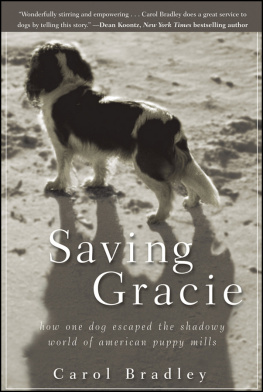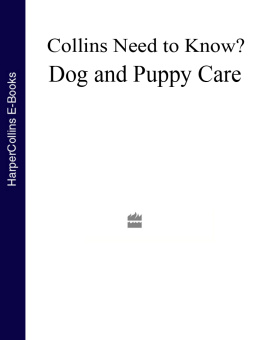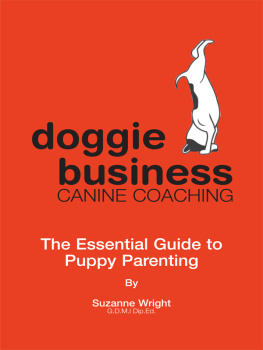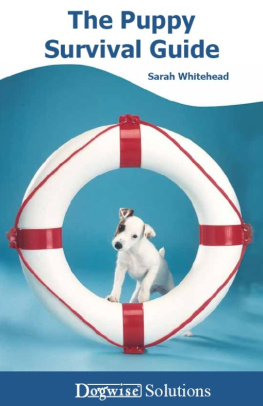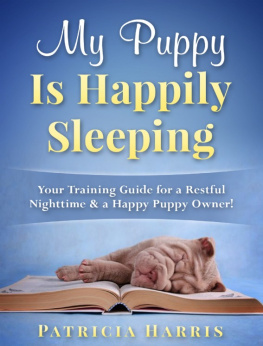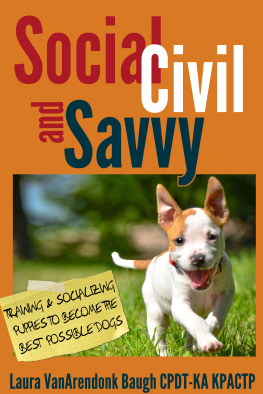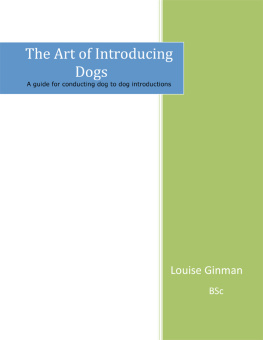Saving Gracie
How One Dog Escaped the Shadowy World of American Puppy Mills
Carol Bradley

This book is printed on acid-free paper.
Copyright 2010 by Carol Bradley. All rights reserved.
Howell Book House
Published by Wiley Publishing, Inc., Hoboken, New Jersey
Credits appear on page 233 and constitute an extension of the copyright page.
No part of this publication may be reproduced, stored in a retrieval system or transmitted in any form or by any means, electronic, mechanical, photocopying, recording, scanning or otherwise, except as permitted under Sections 107 or 108 of the 1976 United States Copyright Act, without either the prior written permission of the Publisher, or authorization through payment of the appropriate per-copy fee to the Copyright Clearance Center, 222 Rosewood Drive, Danvers, MA 01923, (978) 750-8400, fax (978) 646-8600, or on the web at www.copyright.com. Requests to the Publisher for permission should be addressed to the Permissions Department, John Wiley & Sons, Inc., 111 River Street, Hoboken, NJ 07030, (201) 748-6011, fax (201) 748-6008, or online at http://www.wiley.com/go/permissions.
Wiley, the Wiley Publishing logo, Howell Book House, and related trademarks are trademarks or registered trademarks of John Wiley & Sons, Inc. and/or its affiliates. All other trademarks are the property of their respective owners. Wiley Publishing, Inc. is not associated with any product or vendor mentioned in this book.
The publisher and the author make no representations or warranties with respect to the accuracy or completeness of the contents of this work and specifically disclaim all warranties, including without limitation warranties of fitness for a particular purpose. No warranty may be created or extended by sales or promotional materials. The advice and strategies contained herein may not be suitable for every situation. This work is sold with the understanding that the publisher is not engaged in rendering legal, accounting, or other professional services. If professional assistance is required, the services of a competent professional person should be sought. Neither the publisher nor the author shall be liable for damages arising here from. The fact that an organization or Website is referred to in this work as a citation and/or a potential source of further information does not mean that the author or the publisher endorses the information the organization or Website may provide or recommendations it may make. Further, readers should be aware that Internet Websites listed in this work may have changed or disappeared between when this work was written and when it is read.
For general information on our other products and services or to obtain technical support please contact our Customer Care Department within the U.S. at (877) 762-2974, outside the U.S. at (317) 572-3993 or fax (317) 572-4002.
Wiley also publishes its books in a variety of electronic formats. Some content that appears in print may not be available in electronic books. For more information about Wiley products, please visit our web site at www.wiley.com.
ISBN 978-0-470-44758-1
Printed in the United States of America
First Edition
10 9 8 7 6 5 4 3 2 1
Edited by Beth Adelman
Book design by Lissa Auciello-Brogan
Book production by Wiley Publishing, Inc. Composition Services
For Steve,and for Sadie, Delta, Bosco, Chachi, and Jillie,who taught me that all dogs matter.
Preface
The north side of Great Falls, Montana, where I live, is ideal for dog-walking. Craftsman bungalows and 1940s-era houses line the residential streets, and the sidewalks are shaded by towering ash and elm trees. I head out each morning with Chachi, my Husky-Golden mix; my Border Collie, Jillie; and a pocketful of treats to dole out to canine friends along the way. Among the dogs we stop to visit are Bear, a shaggy German Shepherd with kind blue eyes; Jocko, a red-haired mutt who waits eagerly for his prize; and Cody, an Akita whose enormous nose peeks out from under a vinyl fence, quietly passing the time until a biscuit skitters her way.
Every now and then, on a less familiar block, I stumble across a dog confined to a small run, excrement piling up inside, obviously ignored by its family. These animals usually sit too far back from the street to toss a treat tothey would set off an alarming racket if I triedyet I can see the yearning in their eyes as my own dogs trot by. The sight of a lonely, cooped-up dog is distressing. But then I remind myself that even these dogs live like kings compared to dogs confined in puppy mills.
Its one of Americas most shameful secrets: the hidden world of substandard kennels, where dogs are caged like chickens and forced to produce puppies over and over, until they can produce no more. For all the attention we bestow upon mans best friend, all the designer collars we fasten around their necks, the doggy day care programs we enroll them in, and the organic wheat-free premium biscuits we feed them, youd think we would be more curious about where dogs come fromthat wed be more knowledgeable about the bad breeders in our midst and more willing to blow the whistle on them.
In fact, many people are incensed. Do an Internet search on the phrase puppy mills and up pop 1.5 million results. Despite the plethora of information, I am continually surprised at how many of my friends and acquaintances havent a clue that hundreds of thousands of companion animals in this country are living out their lives in barbaric conditions.
I didnt know puppy mills existed either until the fall of 2002, when Collie breeder Athena Lethcoe-Harman and her husband, Jon, tried to relocate their kennel from Alaska to Arizona. To make the 2,240-mile journey, the couple crammed 180 Collies into a tractor trailer, in cages stacked three high, and hit the road without stopping for food or water. By the time their rig crossed into Montana from Canada late on Halloween night, the dogs were wet, shivering, hungry, and yelping loudly enough to alert the customs inspector. He, in turn, contacted law enforcers for rural Toole County. Sheriff Donna Matoon could have taken the easy way out and let the Harmans pass through. Instead, she did the right thing: She ordered a deputy to arrest the couple and charge them with multiple counts of animal cruelty.
The case dragged on for nine months. For much of that time, residents of Shelby, Montana, were left to care for the dogs. They housed them in a barn at the local fairgrounds and devised a complicated schedule for feeding them, walking them, and working to dismantle their fear of human beings. As autumn turned to winter and then to spring, the workload required to operate Camp Collie was nothing short of staggering.
It took two trials to convict the Harmans and free the dogs up for adoption. Before the trials were over, dozens of animal lovers from Florida to California flew in to donate their time on the Collies behalf. When Shelby-area residents became overwhelmed with the task, the dogs were moved to Great Falls, where another army of generous souls stepped forward to do their part.
I covered the case for the Great Falls Tribune , and it opened my eyes to the widespread existence of puppy mills and to the cost, both in real dollars and in human effort, required to salvage their victims. Years later, I still see survivors of Camp Collie around town. Adopted by loving families, most of these beautiful dogs have overcome their past abuse, but some never will forget. They are so scarred by their experience that they still hide in a corner or flinch at the sight of a belt.

